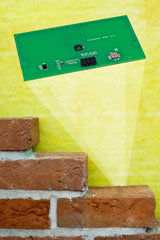Electronica 2014: RFID sensor assists with the detection of moisture damage

Moisture in walls, behind drywall or in floors is all too often the cause behind serious building damage, hygiene problems or unnecessarily high energy costs. Regular inspections can help to detect problem areas or mold in a timely manner and prevent expensive repairs. Typically, moisture is measured using classic gravimetric methods; these methods require samples to be taken and thus cause damage to the building substance, and also take a lot of time as the samples have to be dried in the lab. The researchers at the Fraunhofer-Institut für Photonische Mikrosysteme IPMS thought that there must be an easier way. The scientists in Dresden have developed an RFID moisture sensor that delivers real-time and contact-less results on location using its own energy source. Their research is based on the idea that RFID transponders with an integrated moisture sensor should be built into critical locations during the building phase. The sensors would then be able to deliver measurements over their entire service life, as soon as a reading device is within range and provides the required energy for reading the data. The sensors measure moisture and temperature. This information can also be used to determine the dew point.
At electronica in Munich (11-14 November 2014) - the world trade show for components, systems and applications in the electronics sector - the institute will present its UHF (Ultra-High Frequency) electro-magnetic transponder systems for applications that require measurements to be read over a distance of several meters. The sensor transponder itself consists of an antenna, transponder chip and sensor. The spacing of antennas will depend on the size and type.. Cheque card size transponders for example, can handle distances of several meters. The Fraunhofer technology is an interesting option for many possible application areas thanks to the flexibility of the transponder system, which features an integrated I²C or SPI interface to connect to any external sensor and which can also process analog measurement values of external sensors. The transponder technology from Dresden has already been successfully used in control cabinets for monitoring temperatures at connection points on bus bars. With flows of more than 4000 Ampere, even a small increase in the resistance of these connections will result in a significant rise in temperature. The transponder system can be used to minimize energy losses and prepare targeted maintenance measures. At electronica, the researchers will also be looking for partners for product development, production and distribution for the purpose of developing additional application fields for transponder solutions. Samples for the measurement of temperature, air pressure and moisture are available. Visitors can find the Fraunhofer IPMS presentation in Hall 4 at Stand 113.
 Fraunhofer Institute for Photonic Microsystems
Fraunhofer Institute for Photonic Microsystems